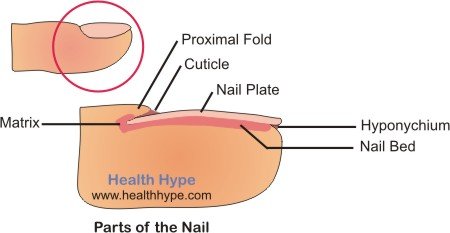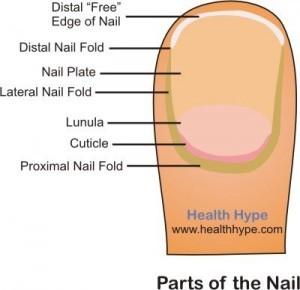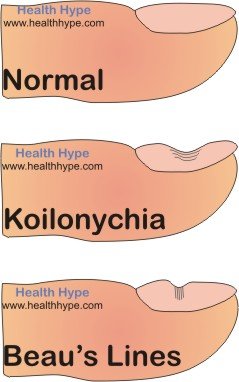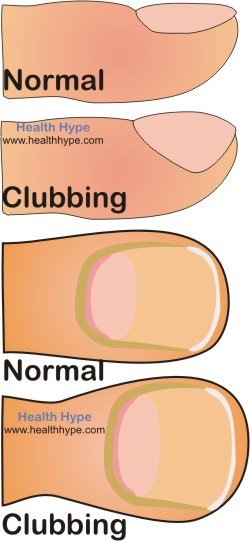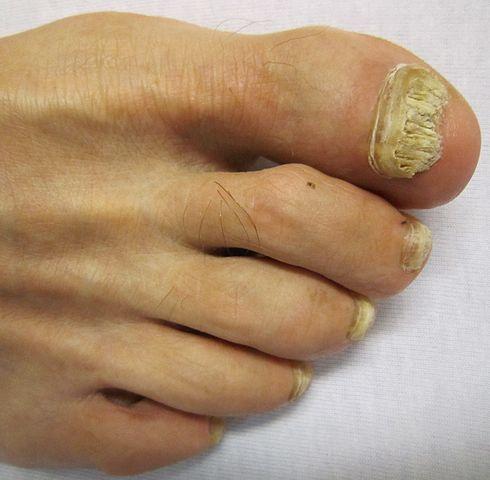Fingernail Abnormalities, Toenail Disorders, Discolored Nails
The nails, like every part of the body, reflects the health of a person and defects of the nail may provide an indication of underlying diseases. Some of these disorders may be early signs of disease whereas other defects arise later in the course of the disease.
Localized causes of nail defects should always be excluded before considering the defect as a sign of systemic disease. Poor nail care, excessive use of cosmetic nail products and nail fungi are common causes of nail defects. This may present as lines on the nail plate, breaking or cracking of the nail, rough nails, thick nails and/or discoloration of the nails.
Healthy Nails
The anatomy of the nail is further discussed under Parts of the Nail.
- The nail plate is the visible part which is often referred to simply as the nail.
- The sides of the nail are surrounded by the nail folds and an extension of the proximal nail fold, known as the cuticle, extends slightly onto the nail plate.
- A crescent-shaped pale area at the proximal area of the nail plate is known as the lunula, which is an extension of the matrix.
Healthy nails are pale pink in color. This is due to the blood flow in the dermal capillaries of the nail bed. The lunula is a lighter pink to almost whitish in color.
The nail plate is a smooth convex surface. It is hard but flexible and will not crack or chip unless exposed to severe force. Changes in the curvature or lines and ridges may be due to a number of diseases. There may be associated changes in the nail color.
Nails grow at a rate of approximately 0.1 mm/day or about 1 centimeter every 3 months. The nail acts as a record of certain illnesses with the longitudinal axis serving as a timeline. The position of any nail deformity, like Beau’s lines, may indicate the time of an illness.
Ridges, Pitting and Curved Nails
Normal Lines and Ridges on the Nails
- Longitudinal ridges (running from the cuticle to the free edge of the nail) may be due to aging and not a sign of any disease.
- Nail beading, where the nail loses its smooth curvature, is also a normal part of aging. Excessive beading that leads to a rough surface may be linked to conditions like rheumatoid arthritis.
- White specks and lines on the nail plate are known as striate leukonychia. It is due to airspaces within the nail plate and is not a sign of calcium deficiency.
Inflamed or Swollen Nail Fold
- This is known as paronychia. It may involve the proximal, lateral and/or distal nail folds and is most commonly due to an infection.
- Bacterial infections often follow trauma to the area, particularly in nail biting where the bacteria in the mouth are transferred onto the broken skin. Habitual picking or biting of the proximal nail folds may also cause recurrent paronychia along with ridges and furrows of the nails.
- Fungal infections are commonly seen with prolonged use of acrylic nails or as secondary infections transferred from a site elsewhere on the body.
- Constantly wet hands (occupational), and excessive manicuring are other causes of paronychia.
- Chronic paronychia may be due to poor peripheral circulation or diabetes.
- Redness of the proximal fold along with uneven or ragged cuticles may be due to connective tissue diseases like dermatomyositis, SLE or systemic sclerosis.
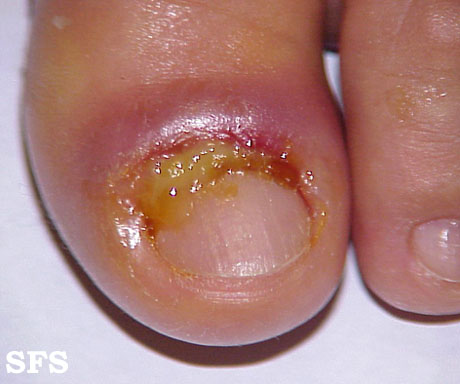
Bacterial Paronychia (source: atlasdermatologico.com.br)
Ridges and Furrows (Grooves) on the Nails
- Beau’s line is a transverse furrow (groove) on the nail plate (refer to the picture below). It may be caused by a number of systemic conditions including :
- severe infection like septicemia
- heart attack (myocardial infarction)
- hypotensive shock
- hypocalcemia
- surgery
- immunosuppressants
- chemotherapy
- zinc deficiency may also be responsible for Beau’s lines. .
- Multiple transverse ridges may be due to :
- eczema
- psoriasis
- chronic paronychia
- habitual-tic dystrophy (discussed below)
- Ladder pattern ridges and furrows may be due to habit-tic dystrophy, which is the habitual picking or biting of the proximal nail folds. The pattern appears as many transverse ridges with longitudinal furrows across the center of the nail. Recurrent paronychia due to a bacterial infection may be noted in the medical history.
- Longitudinal ridges and brittle nails (onychorrhexis) may be due to :
- rheumatoid arthritis
- lichen planus
- Darier’s disease
- peripheral vascular disease
- Central longitudinal ridge may be due to deficiencies related to iron, protein or folic acid
- Central furrow (groove) that is deep like a canal may be due to trauma, severe malnutrition and severe arterial disease.
Curved and Pitting Nails
- Koilonychia is a spoon-shaped depression of the nail plate (refer to the picture above). It mat occur in :
- Iron deficiency anemia
- Systemic lupus erythematosus (SLE)
- Raynaud’s disease
- Diabetes mellitus
- Lichen planus
- Protein deficiency and prolonged exposure to certain detergents may also be responsible for koilonychia in some cases.
- Pitting is the presence of small depressions on the nail plate.
- Fine regular pits are (thimble pitting) and may be due to alopecia areata.
- Larger irregular pits (coarse pitting) may be due to psoriasis, eczema or lichen planus.
- Beaked nails are excessively curved nail plates resembling a bird’s beak. It may be due to :
- Hyperparathyroidism
- Psoriasis
- Renal failure
- Systemic sclerosis
- Nail beading and digital clubbing may also affect the curvature of the nail. Digital clubbing is discussed below.
Digital Clubbing
This is a severe swelling of the fingertips causing it to look like enlarged bulbs. The Lovibond angle between the proximal parts of the nail fold and nail plate is distorted, making the nail look extremely curved or humped (refer to the picture above). Clubbing may be caused by :
- Asbestosis
- Berylliosis
- Mesothelioma
- Lung cancer
- Suppurative lung disease (empyema, bronchiectasis, cystic fibrosis)
- Sarcoidosis
- Congenital heart disease
- Infective endocarditis
- Inflammatory bowel disease
- Biliary cirrhosis
- Thyrotoxicosis (hyperthyroidism)
- Familial causes
Thick Nails
- Age-related thickness of the nail may be seen with age, along with other features like longitudinal ridges. These changes may not be abnormal but causative diseases need to be excluded.
- Onychogryphosis is the malalignment (“crooked”) and thickened toenail often as a result of poorly fitting shoes. Ingrown toenails are a common problem as well. Other causes include age, trauma and psoriasis.
- Pachyonychia congenita is a rare genetic disorder which affects keratin production. It appears as very thick and discolored nails. These signs are present from birth.
- Thickening of the nails (onychauxis) without deformity may also occur as a result of a number of other causes which includes :
- Psoriasis
- Eczema
- Dermatophyte (fungal) infection (onychomycosis) – has a typical yellow discoloration
- Peripheral vascular disease
- Yellow nail syndrome
- Thickening of the finger, particularly the tip, may be related to clubbing.
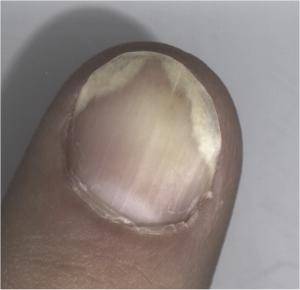
Psoriasis on the Nails
Rough Nails
- Trachyonychia is a fine roughness and white discoloration of the nail plate. It is also known as twenty-nail dystrophy because it involves all 20 nails on the body. Longitudinal ridges, pits, curved nails and a loss of luster may also be noticed. Causes include :
- Lichen planus
- Psoriasis
- Eczema
- Severe alopecia areata
- Other causes of rough nails include :
- Autoimmune diseases
- Prolonged chemical exposure
- Thickening at the tip of the nails may be seen with splinter hemorrhages, red to brown lines.
Nail Beading
Beading changes the smooth curvature of the nails with longitudinal striations that end as bumps at the tip, similar to dripping candle wax. Nail beading may occur with age or could be related to the following conditions :
- Rheumatoid arthritis
- Diabetes mellitus
- Thyroid disorders
- Addison’s disease
- Vitamin B deficiency
Nails Lifting at the Tip
Onycholysis is the separation of the nail plate from the underlying bed at the tip of the finger or toe. Injury to the finger or toe is one of the more common causes but it may associated with other disorders like :
- Psoriasis
- Eczema
- Drugs like tetracycline
- Chemical exposure like strong detergents and solvents
- Autoimmune diseases
- Thyrotoxicosis
Onycholysis, like most nail defects, should not be considered in isolation to identify a possible cause of nail changes. Ridges, lines, pitting, change in curvature, discoloration, thickening and rough nails should also be considered.
Discolored Nails
It is important to differentiate pathology within the nail bed from that of the nail plate itself. One of the most common types of nail discoloration are yellow to brown changes. This is also discussed in detail under brown fingernails, which includes total brown nail discoloration or spots and streaks.
- Red to dark brown streaks
- Red to dark brown longitudinal lines or specks on the nail plate may be splinter hemorrhages. Causes include :
- Trauma
- Infective endocarditis
- Psoriasis
- Systemic lupus erythematosus (SLE)
- Renal failure.
- Brown longitudinal streaks may be due to :
- Melanocytic nevus
- Malignant melanoma
- Addison’s disease
- Racial variants may also be a cause.
- Red to dark brown longitudinal lines or specks on the nail plate may be splinter hemorrhages. Causes include :
- Red to dark brown spots or patches
- Subungal hematomas (bleeding under the nail) may initially appear as a red to maroon or dark brown spot or patch. Usually this occurs as a result of an injury. Over time, this spot or patch to a purple or brown-gray color.
- Yellow to brown nails
- Dermatophyte infection (nail fungus – onychomycosis) – most commonly affects the toenail and causes crumbling of the nails.
- Psoriasis
- Jaundice
- Heat damage
- Addison’s disease
- Amyloidosis
- Drugs like tetracycline, chlorpromazine, gold salts (for rheumatoid arthritis)
- ‘Nicotine stains’ from cigarette smoking
- Yellow nail syndrome is a rare disorder where there is defective lymph drainage leading to lymphedema and pleural effusions or other respiratory disorders like bronchiectasis. It may be due to genetic causes.
- Brown to gray nails
- Vitamin B12 deficiency
- Diabetes mellitus
- Cardiovascular disease
- Breast cancer
- Malignant melanoma
- Lichen planus
- Syphilis
- Exposure to hair dyes, solvents like acetone for removing false (acryclic) nails, nail varnish
- White nails
- Whitish discoloration may be due to :
- Anemia
- Renal (kidney) failure
- Cirrhosis (liver) as a result of hypoalbuminemia (rare)
- Diabetes mellitus
- Chemotherapy
- Rough, white nail (trachyonychia) may be due to lichen planus or severe alopecia areata.
- Half white, half brown or red brown may be due to renal failure or liver disease (Terry’s half and half nails).
- Whitish discoloration may be due to :
- White spots
- Trauma
- Leukonychia stria (due to airspaces, not due to calcium deficiency)
- Shiny nails
- Shiny nails may occur in itchy skin conditions like eczema due to constant scratching and rubbing (buffing) elsewhere on the body. This does not involve the nails itself. Other causes includes excessive buffing for cosmetic purposes.
- Blue nails
- Cyanosis
- Antimalarial drugs
- Subungal hematoma
- Bluish-green to black nails
- Trauma (subungal hematoma)
- Pseudomonas infection (chronic)
- Exposure to chlorophyll derivatives, methyl green or silver nitrate and other chemicals
References
- Examining the Fingernails. Medscape
- Nail Diseases. Dermnet NZ

